Popular categories
Looking for a yarn?
Dreams Of Heather
DROPS knitted jumper with yoke in seed st in ”Classic Alpaca” or DROPS ♥ You #3 or "Belle". Size S-XXXL. Size S-XXXL.
DROPS design: Pattern no AC-016
--------------------------------------------------------
Size: S - M - L - XL - XXL - XXXL
Finished measurements:
Bust: 80-88-96-106-118-130 cm / 31½''-34 5/8''-37¾''-41¾''-46½''-51''
Full length: 66-68-70-72-74-76 cm / 26"-26 3/4"-27½"-28 3/8"-29 1/8"-30"
Materials: DROPS CLASSIC ALPACA from Garnstudio
500-550-600-650-700-800 g color no 4434m, purple/violet mix
Or use:
DROPS BELLE from Garnstudio
400-450-450-500-550-600g colour no 19, dark violet
Or use:
DROPS ♥ You #3 from Garnstudio
Colour no 07, royal blue
300-350-400-400-450-500 g
DROPS DOUBLE POINTED NEEDLES and CIRCULAR NEEDLE (80 cm / 32'') size 4 mm/US 6 - or size needed to get 21 sts x 28 rows in stockinette st = 10 x 10 cm / 4'' x 4''.
DROPS DOUBLE POINTED NEEDLES and CIRCULAR NEEDLE (80 cm / 32'') size 3.5 mm/US 4 - for rib.
-------------------------------------------------------
Alternative Yarn – See how to change yarns here
Yarn Groups A to F – Use the same pattern and change the yarn here
Yarn usage using an alternative yarn – Use our yarn converter here
-------------------------------------------------------
- English (US/in)
- Česky
- Dansk
- Deutsch
- Eesti keel
- English (UK/cm)
- Español
- Français
- Íslenska - not translated
- Italiano
- Magyar
- Nederlands
- Norsk
- Polski
- Português
- Suomi
- Svenska
- English (UK/cm), Bulgaria
- English (UK/cm), Croatia
- English (UK/cm), Greece
- English (UK/cm), Latvia
- English (UK/cm), Lithuania
- English (UK/cm), Romania
- English (UK/cm), Slovenia
- Česky, Slovakia
Pattern instructions
Row 1 (= RS): *1 K, P1 *, repeat from *-*.
Row 2 (= WS): K over K and P over P.
Row 3 (= RS): *P1, 1 K *, repeat from *-*.
Row 4 (= WS): P over P and K over K.
Repeat row 1-4.
--------------------------------------------------------
BODY PIECE:
Worked in the round. Cast on 243-264-288-318-351-384 sts on circular needle size 3.5 mm / US 4 with Classic Alpaca. Work rib K1/P2. When piece measures 4 cm / 1½'' work 1 round stockinette st, AT THE SAME TIME dec 59-64-72-78-87-96 sts evenly (dec by K tog approx every 3rd and 4th st) = 184-200-216-240-264-288 sts. Insert 2 markers in piece, at beg of round and after 92-100-108-120-132-144 sts (to mark the sides). Change to circular needle size 4 mm / US 6. Continue in the round in stockinette st. REMEMBER THE GAUGE!
When piece measures 8 cm / 3 1/8'' dec 1 st each side of both markers. Repeat the dec on every 3.5 cm / 1 1/4'' a total of 6 times = 160-176-192-216-240-264 sts. When piece measures 31 cm / 12 1/4'' inc 1 st each side of both markers (inc with 1 YO, on next round K YO into back of loop). Repeat the inc when piece measures 41-42-43-44-45-46 cm / 16 1/8''-16½''-17''-17¼''-17¾''-18'' = 168-184-200-224-248-272 sts. When piece measures 47-48-49-50-51-52 cm / 18½''-19''-19¼''-19¾''-20''-20½'' work DOUBLE SEED ST – see above – AT THE SAME TIME bind off 6 sts each side for armhole (3 sts each side of marker).
Now complete each piece separately.
BACK PIECE:
= 78-86-94-106-118-130 sts (Row 1 = WS). Continue in double seed st AT THE SAME TIME bind off for armhole at beg of every row each side as follows: 2 sts 0-1-2-4-6-8 times and 1 st 1-2-3-4-5-6 times = 76-78-80-82-84-86 sts. When piece measures 64-66-68-70-72-74 cm / 25¼''-26''-26¾''-27½''-28 3/8''-29 1/8'' bind off the middle 24-26-28-30-32-34 sts for neck and complete each shoulder separately.
Dec 1 st on neckline on next row (dec by working the 2 outermost sts tog) = 25 sts left on shoulder for all sizes. Bind off when piece measures 66-68-70-72-74-76 cm / 26''-26¾''-27½''-28 3/8''-29 1/8''-30''.
FRONT PIECE:
= 78-86-94-106-118-130 sts (Row 1 = WS). Continue in double seed st and bind off for armhole as described for back piece, AT THE SAME TIME after 4 rows of pattern (= 1 pattern repeat) bind off the middle 2 sts for neck from RS and complete each shoulder separately.
Now bind off to shape the neckline by working 2 sts tog on neckline (work them tog to fit pattern) at the beg of every row from neck a total of 12-13-14-15-16-17 times.
When all dec are complete there are 25 sts left on shoulder for all sizes. Bind off when piece measures 66-68-70-72-74-76 cm / 26''-26¾''-27½''-28 3/8''-29 1/8''-30''.
SLEEVE:
Worked in the round. Cast on 63-66-69-72-75-78 sts on double pointed needles size 3.5 mm / US 4 with Classic Alpaca. Work rib K1/P2. When piece measures 4 cm / 1½'' K 1 round, AT THE SAME TIME dec 15-16-17-18-19-20 sts evenly (dec by working approx every 3rd and 4th st tog) = 48-50-52-54-56-58 sts. Change to double pointed needles size 4 mm / US 6 and insert a marker at beg of round. Continue in stockinette st.
When piece measures 8 cm / 3 1/8'' inc 1 st each side of marker. Repeat the inc on every 4-3.5-3-2.5-2-2 cm / 1½''-1¼''-1 1/8''-7/8''-3/4''-3/4'' a total of 10-11-13-15-17-18 times = 68-72-78-84-90-94 sts. When piece measures 50-50-49-49-47-46 cm / 19 3/4"-19 3/4"-19 1/4"-19 1/4"-18½"-18" (NOTE! Less for the larger sizes because of longer sleeve cap and wider shoulder) continue in double seed st on all sts, AT THE SAME TIME bind off 6 sts mid under sleeve (3 sts each side of marker). Now continue back and forth on needle. Continue to bind off for sleeve cap at beg of row each side as follows: 2 sts 3-3-4-4-4-3 times and 1 st 3-4-4-5-8-13 times, then bind off 2 sts each side until piece measures 57-58-58-59-59-60 cm / 22½''-22¾''-22¾''-23¼''-23¼''-23 5/8'', now bind off 3 sts 1 time each side. Bind off remaining sts.
ASSEMBLY:
Sew shoulder seams. Set in sleeves.
Diagram
All measurements in charts are in cm.
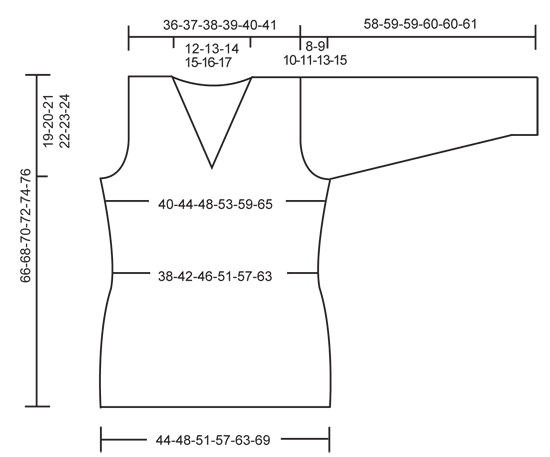
What can you do with our patterns? You can share DROPS patterns online, using the pattern original picture, materials, name and number. But you are NOT ALLOWED to reproduce the complete pattern digitally in any way. Yarn stores are welcome to use the DROPS pattern database to promote the sale of our assortment. You can print out our patterns, make as many copies as you’d like. The only thing we ask is that you don't make any changes / additions to the original printed document. And that the patterns according to the DROPS philosophy are given out to the consumers for free. Editorials that wish to publish our patterns in printed books or magazines can contact us for more information. The sale of garments based on DROPS patterns is permitted as long as they are sold as single items or per order. Further commercial use of the patterns is not permitted. It has to be clearly stated that the garment is made based on a design from DROPS DESIGN. The use of clothing labels of which DROPS DESIGN forms part is conditioned by the inclusion of the following text: “A DROPS DESIGN made by …..”. The use of DROPS photos for marketing purposes/sales is only permitted in connection with the use/sale of DROPS products. The photos may not be cut or edited and the logo should be clearly visible.
We reserve the right to withdraw the permission for use of our patterns at any time, notwithstanding the reason.
Each of our patterns has specific tutorial videos to help you.
These step-by-step tutorials might also help you:
Why is the knitting/crochet tension so important?
Knitting tension is what determines the final measurements of your work, and is usually measured per 10 x 10 cm. It is provided like so: number of stitches in width x number of rows in height - eg: 19 stitches x 26 rows = 10 x 10 cm.
The knitting tension is very individual; some people knit/crochet loosely while others work tightly. You adjust the knitting tension with the needle size, which is why the suggested needle size only serve as a guide! You need to adjust this (up or down) to ensure that YOUR knitting tension matches the knitting tension provided in the pattern. If you work with a different knitting tension than provided you will have a different yarn consumption, and your work will have different measurements than what the pattern suggests.
The knitting tension also determines which yarns can replace each other. As long as you achieve the same knitting tension you can replace one yarn with another.
See DROPS lesson: How to measure your tension/gauge
See DROPS video: How to make a gauge tension swatch
How do I know how many balls of yarn I need?
The required amount of yarn is provided in grams, eg: 450 g. To calculate how many balls you’ll need you first need to know how many grams are in 1 ball (25g, 50g or 100g). This information is available if you click on the individual yarn quality on our pages. Divide the amount required with the amount of each ball. For example, if each ball is 50g (the most common amount), the calculation will be as follows: 450 / 50 = 9 balls.
Can I use a different yarn than what the pattern suggests?
The important thing when changing from one yarn to another is that the knitting/crochet tension remains the same. This is so that the measurements of the finished piece will be the same as on the sketch provided. It is easier to achieve the same knitting tension using yarns from the same yarn group. It is also possible to work with multiple strands of a thinner yarn to achieve the knitting tension of a thicker one. Please try our yarn converter. We recommend you to always work a test swatch.
Please NOTE: when changing yarn the garment might have a different look and feel to the garment in the photo, due to individual properties and qualities of each yarn.
See DROPS lesson: Can I use a different yarn than the one mentioned in the pattern?
What are the yarn groups?
All our yarns are categorised into yarn groups (from A to F) according to thickness and knitting tension – group A contains the thinnest yarns and group F the thickest. This makes it easier for you to find alternative yarns to our patterns, should you wish to switch yarn. All yarns within the same group have a similar knitting tension and can easily replace each other. However, different yarn qualities have different structures and properties which will give the finished work a unique look and feel.
How do I use the yarn converter?
At the top of all our patterns you’ll find a link to our yarn converter, which is a helpful tool should you wish to use a different yarn than suggested. By filling in the yarn quality you wish to replace, the amount (in your size) and number of strands, the converter will present good alternative yarns with the same knitting tension. Additionally it will tell you how much you’ll require in the new qualities and whether you’ll need to work with multiple strands. Most skeins are 50g (some are 25g or 100g).
If the pattern is worked with multiple colours, every colour will have to be converted separately. Similarly, if the pattern is worked with several strands of different yarns (for example 1 strand Alpaca and 1 strand Kid-Silk) you will have to find alternatives for each, individually.
Why do you show discontinued yarns in the patterns?
Since different yarns have different qualities and textures we have chosen to keep the original yarn in our patterns. However, you can easily find options among our available qualities by using our yarn converter, or simply pick a yarn from the same yarn group.
It is possible that some retailers still have discontinued yarns in stock, or that someone has a few skeins at home that they would like to find patterns for.
The yarn converter will provide both alternative yarn as well as required amount in the new quality.
What size should I knit?
If you think it's hard to decide what size to make, it can be a good idea to measure a garment you own already and like the size of. Then you can pick the size by comparing those measures with the ones available in the pattern's size chart.
You'll find the size chart at the bottom of the pattern.
See DROPS lesson: How to read size chart
Why do I get the wrong knitting tension with the suggested needle size?
The needle size provided in the pattern serves only as a guide, the important thing is to follow the knitting tension. And since knitting tension is very individual, you will have to adjust the needle size to ensure that YOUR tension is the same as in the pattern – maybe you’ll have to adjust 1, or even 2 needle sizes, up or down to achieve the correct tension. For this, we recommend that you work test swatches.
Should you work with a different knitting tension than the one provided, the measurements of the finished garment might deviate from the measurement sketch.
See DROPS lesson: How to measure your tension/gauge
See DROPS video: How to make a gauge tension swatch
Why is the pattern worked top-down?
Working a garment top-down provides more flexibility and room for personal adjustment. For example it is easier to try the garment on while working, as well as making adjustments to length of yoke and shoulder caps.
The instructions are carefully explaining every step, in the correct order. Diagrams are adjusted to the knitting direction and are worked as usual.
How do I work according to a knitting diagram?
The diagram depicts all rows/rounds, and every stitch seen from the right side. It is read from bottom to top, from right to left. 1 square = 1 stitch.
When working back and forth, every other row is worked from the right side and every other row is worked from the wrong side. When working from the wrong side, the diagram will have to be worked reversed: from left to right, knit stitches are purled, purl stitches are knit etc.
When working in the round every round is worked from the right side and the diagram are worked from right to left on all rounds.
See DROPS lesson: How to read knitting diagrams
How do I work according to a crochet diagram?
The diagram depicts all rows/rounds, and every stitch seen from the right side. It is worked from bottom to top, from right to left.
When working back and forth every other row is worked from the right side: from right to left and every other row is worked from the wrong side: from left to right.
When working in the round, every row in the diagram are worked from the right side, from right to left.
When working a circular diagram you start in the middle and work your way outwards, counter clockwise, row by row.
The rows usually start with a given number of chain stitches (equivalent to the height of the following stitch), this will either be depicted in the diagram or explained in the pattern.
See DROPS lesson: How to read crochet diagrams
How do I work several diagrams simultaneously on the same row/round?
Instructions for working several diagrams after each other on the same row/round, will often be written like so: “work A.1, A.2, A.3 a total of 0-0-2-3-4 times". This means you work A.1 once, then A.2 is worked once, and A.3 is repeated (in width) the number of times provided for your size – in this case like so: S = 0 times, M = 0 times, L=2 times, XL= 3 times and XXL = 4 times.
The diagrams are worked as usual: begin with the first row in A.1, then work the first row in A.2 etc.
See DROPS lesson: How to read knitting diagrams
See DROPS lesson: How to read crochet diagrams
Why are the sleeves shorter in larger sizes?
The total width of the garment (from wrist-to-wrist) will be larger in the larger sizes, despite the actual sleeves being shorter. The larger sizes have longer sleeve caps and wider shoulders, so there will be a good fit in all sizes.
Where on the garment is the length measured?
The measurement sketch/schematic drawing provides information regarding the full length of the garment. If it’s a jumper or a jacket the length is measured from the highest point on the shoulder (usually closest to the neckline), and straight down to the bottom of the garment. It is NOT measured from the tip of shoulder. Similarly, the length of yoke is measured from the highest point on the shoulder and down to where yoke is split into body and sleeves.
See DROPS lesson: How to read a schematic drawing
What is a repeat?
Diagrams are often repeated on the round or in height. 1 repeat is the diagram the way it appears in the pattern. If it says to work 5 repeats of A.1 in the round, then you work A.1 a total of 5 times after/next to each other in the round. If it says to work 2 repeats of A.1 vertically/in height you work the entire diagram once, then begin again at the start and work the entire diagram one more time.
Why does the piece start with more chain stitches than it’s worked with?
Chain stitches are slightly narrower than other stitches and to avoid working the cast-on edge too tight, we simply chain more stitches to begin with. The stitch count will be adjusted on the following row to fit the pattern and measurement sketch.
Why increase before the rib edge when the piece is worked top-down?
The rib edge is more elastic and will contract slightly compared to, for example, stocking stitch. By increasing before the rib edge, you avoid a visible difference in width between the rib edge and the rest of the body.
Why increase in the cast-off edge?
It’s very easy to cast off too tightly, and by making yarn overs while casting off (and simultaneously casting these off) you avoid a too tight cast off edge.
See DROPS video: How to bind off with yarn overs (yo)
How do I increase/decrease on every 3rd and 4th row/round alternately?
To achieve an even increase (or decrease) you can increase on, for example: every 3rd and 4th row alternately, like so: work 2 rows and increase on the 3rd row, work 3 rows and increase on the 4th. Repeat this until the increase is complete.
See DROPS lesson: Increase or decrease 1 st on every 3rd and 4th row alternately
How can I work a jacket in the round instead of back and forth?
Should you prefer to work in the round instead of back and forth, you may of course adjust the pattern. You’ll need to add steeks mid-front (usually 5 stitches), and follow the instructions. When you would normally turn and work from the wrong side, simply work across the steek and continue in the round. At the end you’ll cut the piece open, pick up stitches to work bands, and cover the cut edges.
See DROPS video: How to knit steeks and cut open
Can I work a jumper back and forth instead of in the round?
Should you prefer to work back and forth instead of in the round, you may of course adjust the pattern so you work the pieces separately and then assemble them at the end. Divide the stitches for the body in 2, add 1 edge stitch in each side (for sewing) and work the front and back pieces separately.
See DROPS lesson: Can I adapt a pattern for circular needles into straight needles?
Why is the pattern slightly different than what I see in the photo?
Pattern repeats can vary slightly in the different sizes, in order to get the correct proportions. If you’re not working the exact same size as the garment in the photo, yours might deviate slightly. This has been carefully developed and adjusted so that the complete impression of the garment is the same in all sizes.
Make sure to follow instructions and diagrams for your size!
How do I make a women’s size garment into a men’s size one?
If you have found a pattern you like which is available in women’s size it’s not very difficult to convert it to men’s size. The biggest difference will be the length of sleeves and body. Start working on the women size that you think would fit across the chest. The additional length will be worked right before you cast off for the armhole/sleeve cap. If the pattern is worked top-down you can add the length right after the armhole or before the first decrease on sleeve.
Regarding additional yarn amount, this will depend on how much length you add, but it is better with a skein too many than too few.
How do I prevent a hairy garment from shedding?
All yarns will have excess fibres (from production) that might come off as lint or shedding. Brushed yarns (ie hairier yarns) have more of these loose, excess fibres, causing more shedding.
Shedding also depends on what is worn under or over the garment, and whether this pulls at the yarn fibres. It’s therefore not possible to guarantee that there will be no shedding
Below are some tips on how to get the best result when working with hairier yarns:
1. When the garment is finished (before you wash it) shake it vigorously so the looser hairs come off. NOTE: do NOT use a lint roller, brush or any method that pulls at the yarn.
2. Place the garment in a plastic bag and put it in your freezer - the temperature will cause the fibres to become less attached to each other, and excess fibres will come off easier.
3. Leave in the freezer for a few hours before taking it out and shaking it again.
4. Wash the garment according to the instructions on the yarn label.
Why does my garment pill?
Pilling is a natural process that happens to even the most exclusive of fibers. It's a natural sign of wear and tear that is hard to avoid, and that is most visible in high friction areas of your garment like a sweater's arms and cuffs.
You can make your garment look as new by removing the pilling, using a fabric comb or a pill/lint remover.
In the meantime, you can read the questions and answers that others have left to this pattern or join the DROPS Workshop on Facebook to get help from fellow knitters/crocheters!
Dreams Of Heather |
|
|
|
|
DROPS knitted jumper with yoke in seed st in ”Classic Alpaca” or DROPS ♥ You #3 or "Belle". Size S-XXXL. Size S-XXXL.
DROPS 123-3 |
|
|
DOUBLE SEED ST: Row 1 (= RS): *1 K, P1 *, repeat from *-*. Row 2 (= WS): K over K and P over P. Row 3 (= RS): *P1, 1 K *, repeat from *-*. Row 4 (= WS): P over P and K over K. Repeat row 1-4. -------------------------------------------------------- BODY PIECE: Worked in the round. Cast on 243-264-288-318-351-384 sts on circular needle size 3.5 mm / US 4 with Classic Alpaca. Work rib K1/P2. When piece measures 4 cm / 1½'' work 1 round stockinette st, AT THE SAME TIME dec 59-64-72-78-87-96 sts evenly (dec by K tog approx every 3rd and 4th st) = 184-200-216-240-264-288 sts. Insert 2 markers in piece, at beg of round and after 92-100-108-120-132-144 sts (to mark the sides). Change to circular needle size 4 mm / US 6. Continue in the round in stockinette st. REMEMBER THE GAUGE! When piece measures 8 cm / 3 1/8'' dec 1 st each side of both markers. Repeat the dec on every 3.5 cm / 1 1/4'' a total of 6 times = 160-176-192-216-240-264 sts. When piece measures 31 cm / 12 1/4'' inc 1 st each side of both markers (inc with 1 YO, on next round K YO into back of loop). Repeat the inc when piece measures 41-42-43-44-45-46 cm / 16 1/8''-16½''-17''-17¼''-17¾''-18'' = 168-184-200-224-248-272 sts. When piece measures 47-48-49-50-51-52 cm / 18½''-19''-19¼''-19¾''-20''-20½'' work DOUBLE SEED ST – see above – AT THE SAME TIME bind off 6 sts each side for armhole (3 sts each side of marker). Now complete each piece separately. BACK PIECE: = 78-86-94-106-118-130 sts (Row 1 = WS). Continue in double seed st AT THE SAME TIME bind off for armhole at beg of every row each side as follows: 2 sts 0-1-2-4-6-8 times and 1 st 1-2-3-4-5-6 times = 76-78-80-82-84-86 sts. When piece measures 64-66-68-70-72-74 cm / 25¼''-26''-26¾''-27½''-28 3/8''-29 1/8'' bind off the middle 24-26-28-30-32-34 sts for neck and complete each shoulder separately. Dec 1 st on neckline on next row (dec by working the 2 outermost sts tog) = 25 sts left on shoulder for all sizes. Bind off when piece measures 66-68-70-72-74-76 cm / 26''-26¾''-27½''-28 3/8''-29 1/8''-30''. FRONT PIECE: = 78-86-94-106-118-130 sts (Row 1 = WS). Continue in double seed st and bind off for armhole as described for back piece, AT THE SAME TIME after 4 rows of pattern (= 1 pattern repeat) bind off the middle 2 sts for neck from RS and complete each shoulder separately. Now bind off to shape the neckline by working 2 sts tog on neckline (work them tog to fit pattern) at the beg of every row from neck a total of 12-13-14-15-16-17 times. When all dec are complete there are 25 sts left on shoulder for all sizes. Bind off when piece measures 66-68-70-72-74-76 cm / 26''-26¾''-27½''-28 3/8''-29 1/8''-30''. SLEEVE: Worked in the round. Cast on 63-66-69-72-75-78 sts on double pointed needles size 3.5 mm / US 4 with Classic Alpaca. Work rib K1/P2. When piece measures 4 cm / 1½'' K 1 round, AT THE SAME TIME dec 15-16-17-18-19-20 sts evenly (dec by working approx every 3rd and 4th st tog) = 48-50-52-54-56-58 sts. Change to double pointed needles size 4 mm / US 6 and insert a marker at beg of round. Continue in stockinette st. When piece measures 8 cm / 3 1/8'' inc 1 st each side of marker. Repeat the inc on every 4-3.5-3-2.5-2-2 cm / 1½''-1¼''-1 1/8''-7/8''-3/4''-3/4'' a total of 10-11-13-15-17-18 times = 68-72-78-84-90-94 sts. When piece measures 50-50-49-49-47-46 cm / 19 3/4"-19 3/4"-19 1/4"-19 1/4"-18½"-18" (NOTE! Less for the larger sizes because of longer sleeve cap and wider shoulder) continue in double seed st on all sts, AT THE SAME TIME bind off 6 sts mid under sleeve (3 sts each side of marker). Now continue back and forth on needle. Continue to bind off for sleeve cap at beg of row each side as follows: 2 sts 3-3-4-4-4-3 times and 1 st 3-4-4-5-8-13 times, then bind off 2 sts each side until piece measures 57-58-58-59-59-60 cm / 22½''-22¾''-22¾''-23¼''-23¼''-23 5/8'', now bind off 3 sts 1 time each side. Bind off remaining sts. ASSEMBLY: Sew shoulder seams. Set in sleeves. |
|

|
|
|
Have you made this or any other of our designs? Tag your pictures in social media with #dropsdesign so we can see them! Do you need help with this pattern?You'll find tutorial videos, a Comments/Questions area and more by visiting the pattern on garnstudio.com. © 1982-2024 DROPS Design A/S. We reserve all rights. This document, including all its sub-sections, has copyrights. Read more about what you can do with our patterns at the bottom of each pattern on our site. |
With over 40 years in knitting and crochet design, DROPS Design offers one of the most extensive collections of free patterns on the internet - translated to 17 languages. As of today we count 304 catalogs and 11422 patterns - 11417 of which are translated into English (US/in).
We work hard to bring you the best knitting and crochet have to offer, inspiration and advice as well as great quality yarns at incredible prices! Would you like to use our patterns for other than personal use? You can read what you are allowed to do in the Copyright text at the bottom of all our patterns. Happy crafting!

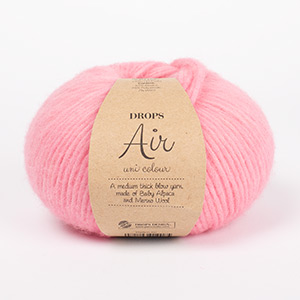







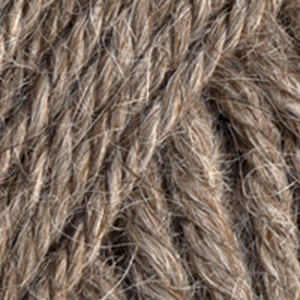
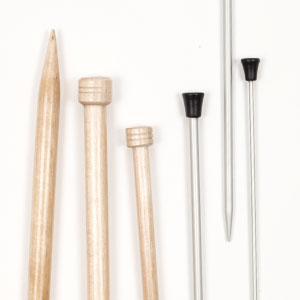
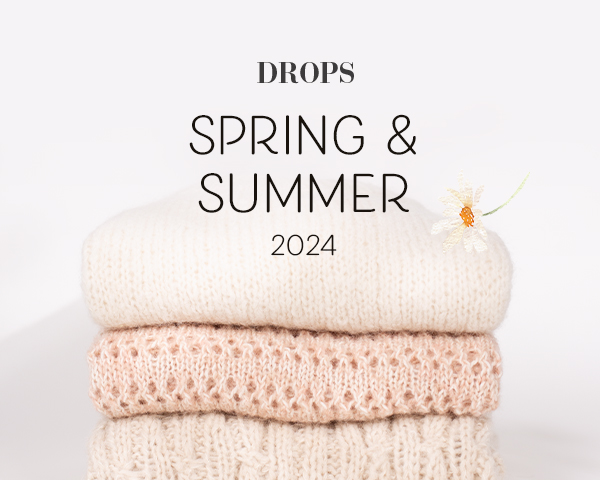
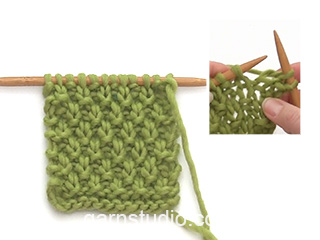
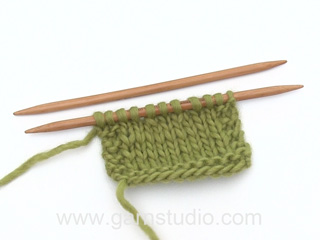
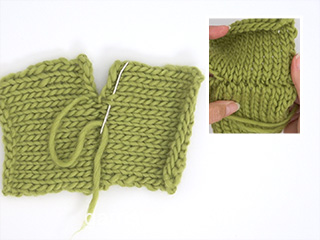
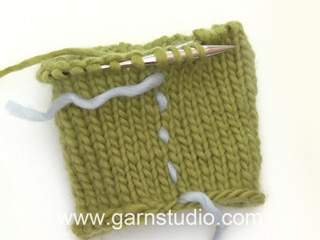
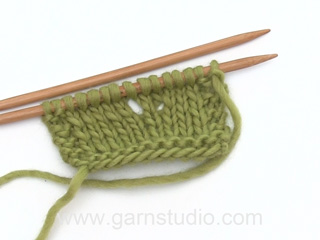
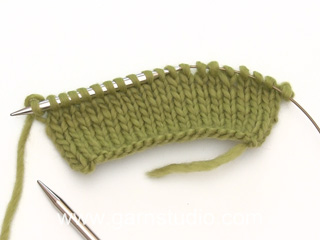

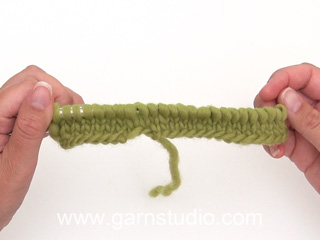
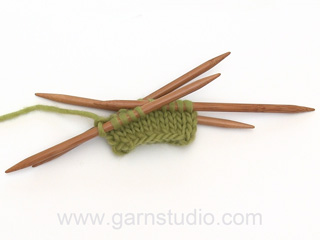
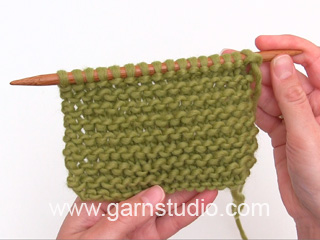
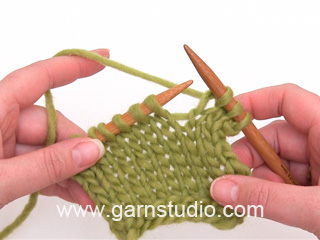
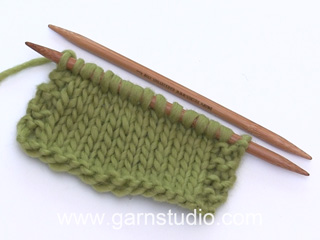
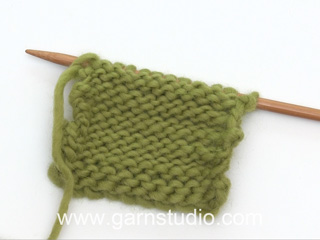
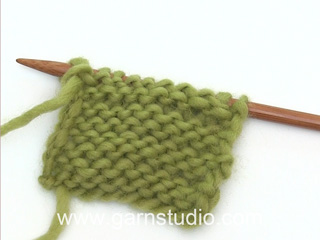


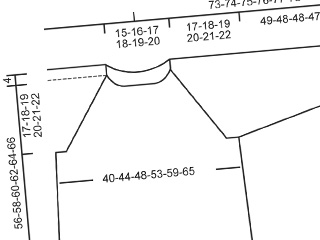
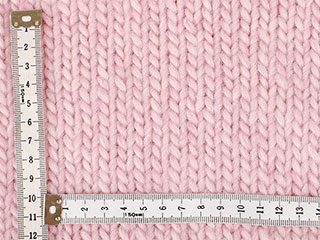
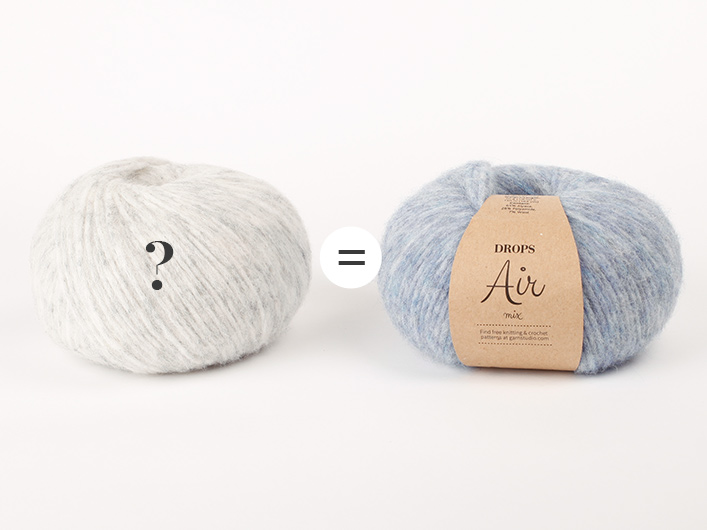

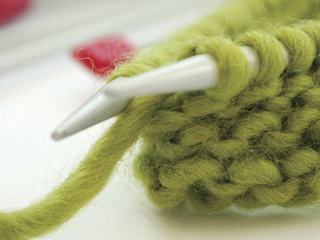
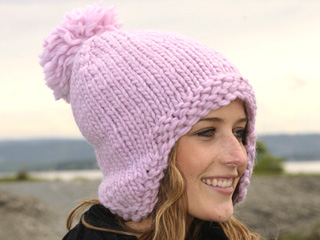
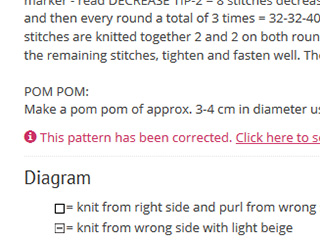
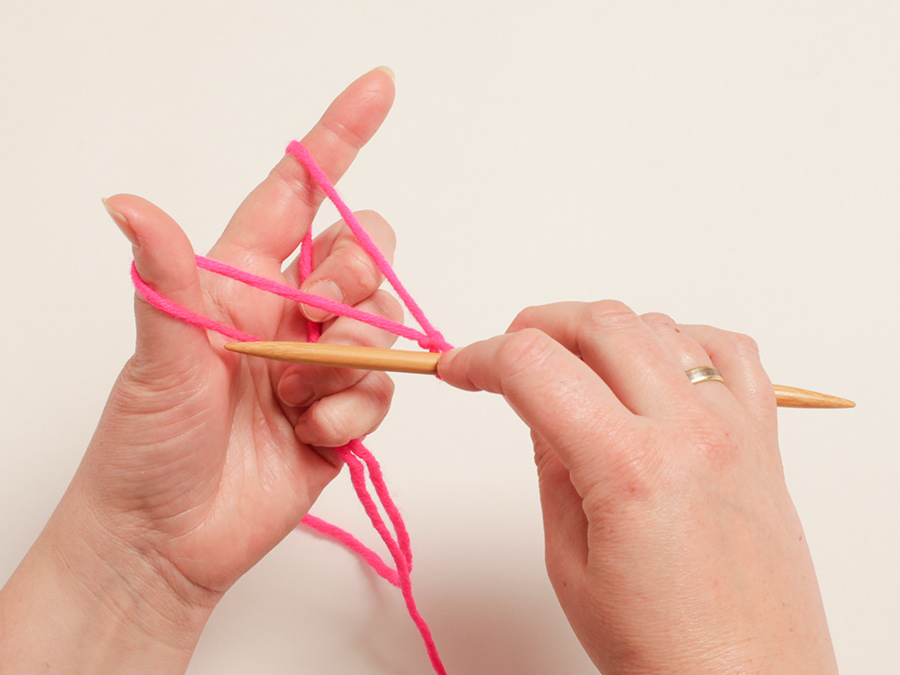
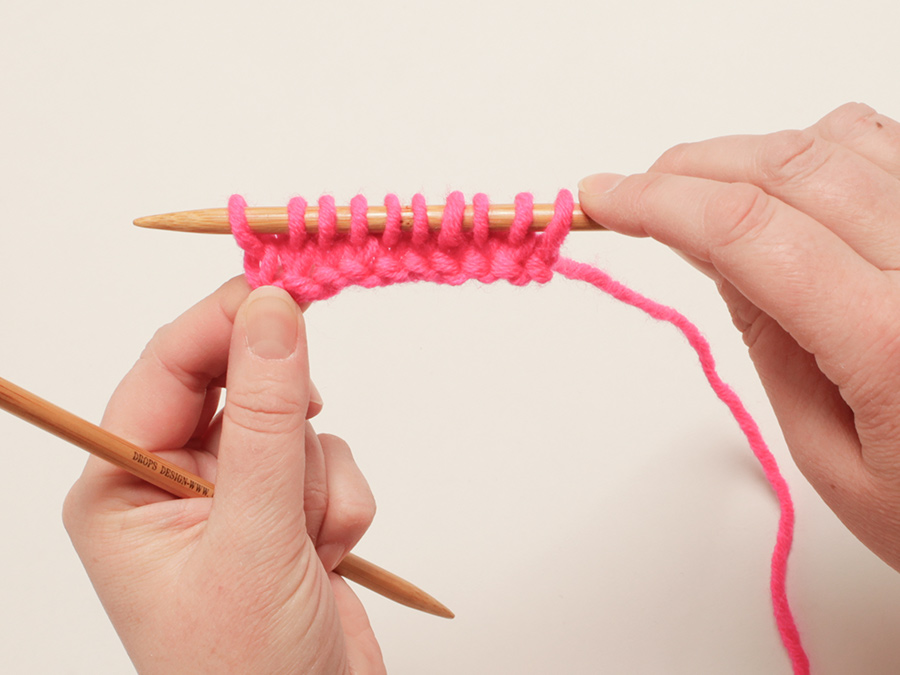

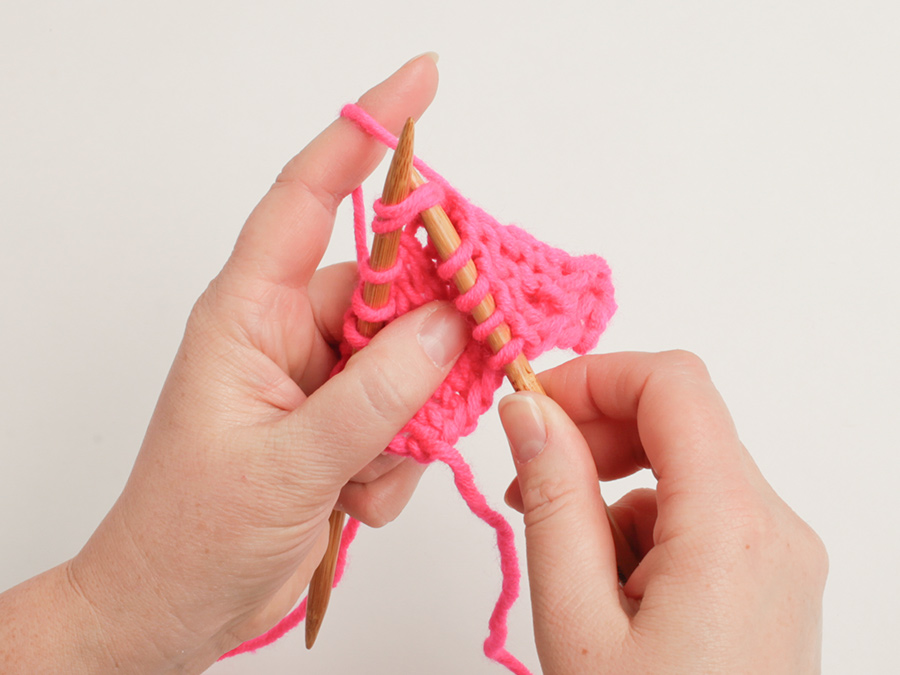
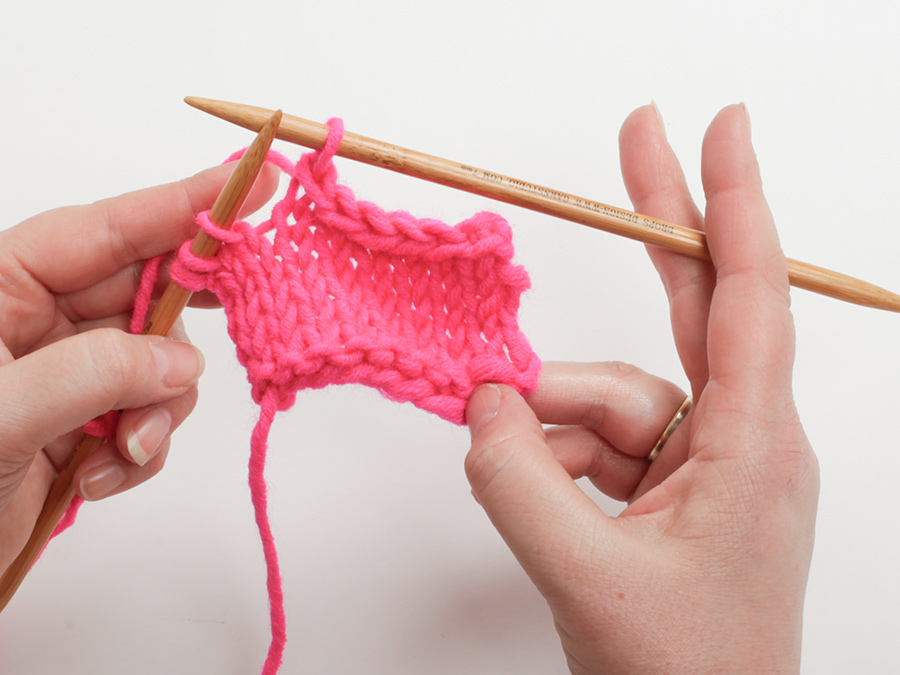
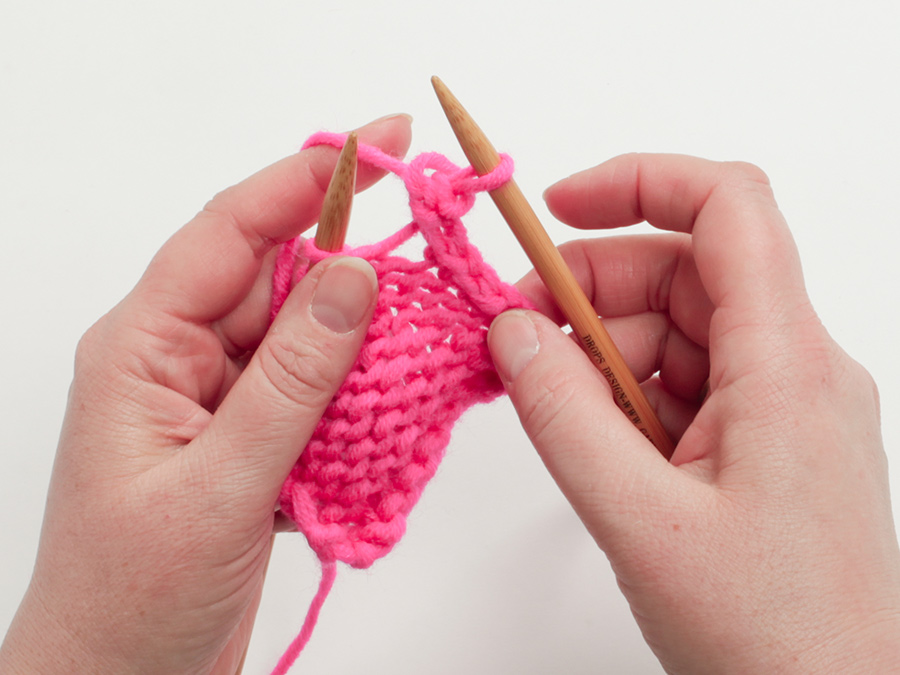
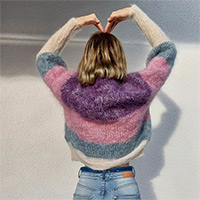
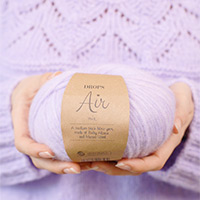
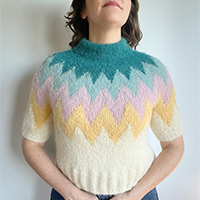
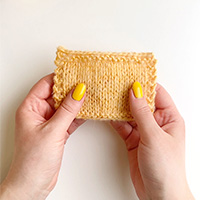
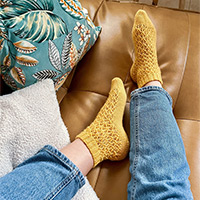
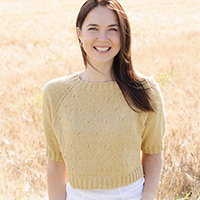
Comments / Questions (86)
Patati0 wrote:
Bonjour, J'ai vu ce modele et dans les explications pour le dos tout seul,ils ne disent pas la grandeur des aiguilles,quelles aiguilles dois-je prendre?.
29.03.2014 - 01:27DROPS Design answered:
Bonjour Patati0, pour le dos, on monte les mailles avec l'aiguille circulaire 3,5 et on continue ensuite avec l'aiguille circulaire 4. Quand on termine chaque pièce séparément, on continue avec la même aiguille qu'avant (= 4). Bon tricot!
29.03.2014 - 10:37Should the pattern at the top of the sleeves be moss/seed stitch or double moss/seed stitch as in the body? The pattern says moss stitch but it's difficult to tell from the picture whether it means double or single... Thanks!
23.02.2014 - 22:33DROPS Design answered:
Dear Sally, at the top of sleeve work in double moss/seed st in height. Happy knitting!
24.02.2014 - 10:24Is there errata for this pattern. Back shows incorrect armhole decreases. After ripping out all that double moss stitch, I want to see if there is more to watch out for. Thanks!
10.01.2014 - 03:45DROPS Design answered:
Dear Aryn, pattern has been checked one more time and dec for armhole are correct as they are. Happy knitting!
10.01.2014 - 09:46Mon pull est fini, et je l'aime d'amour, merci DROPS pour ces modèles fabuleux que vous nous proposez toujours ! Par contre, il m'a fallu 11 pelotes, et non 10, pour une taille M, en Karisma. ça peut servir à d'autres ;-) Le pull est visible ici sur mon blog =)
02.12.2013 - 12:56Bonjour l'équipe Drops ! Je suis en train de faire ce modèle, il me plaît beaucoup ! Par contre je le tricote en Karisma, j'avais calculé qu'il me faudrait 10 pelotes, mais là j'ai bientôt fini le corps, il va me rester les manches à faire, et j'ai un gros doute sur la quantité de laine. J'avais prévu 10 pelotes de Karisma pour une taille M, vous en pensez quoi ?
07.11.2013 - 16:45DROPS Design answered:
Bonjour Ophelia, le calcul mathématique de 10 pelotes paraît juste, sur la base d'une tension identique. Si vous avez un doute, n'hésitez pas à contacter le magasin où vous avez acheté votre laine. Bon tricot!
08.11.2013 - 09:03Ik ben helemaal klaar met het breien van deze mooie trui. maar bij het in elkaar zetten kom ik erachter dat de mouwen niet mooi aansluiten op het lijf. onderaan bij de oksel wijken de delen van elkaar af ipv dat ze naast elkaar liggen
03.10.2013 - 20:37DROPS Design answered:
De vorm van de mouwen en de armsgaten voor deze trui is standaard. Een mouwkop is anders van vorm dan een armsgat. Werk als volgt: Speld eerst midden mouwkop aan rand schouder en speld onderkant mouw op onderkant armgat. Leid nu mouwrand langs armgatranden, speld vast en naai vast. Succes!
18.10.2013 - 16:35Hallo Ich glaube ich habe einen Fehler gefunden.Und zwar bei der Zunahme nach 31cm.Eigentlich müsste ich beidseitig 4 Maschen zunehmen aber es steht da einmal nach 31 cm und dann noch mal nach41cm zunehmen.Dies ergibt bei mir keine 168 Maschen sondern 164 Maschen.Vieleicht kann mir da jemand helfen. Claudia
15.09.2013 - 19:00Lena answered:
Man nimmt 4 Maschen zu und das zweimal( beiderseits der Markierungen)
15.09.2013 - 19:27How do I know the yardage required based on g?
17.07.2013 - 03:02DROPS Design answered:
Dear Mazie, you will have all informations on our yarns clicking on the link :"See deals and shadecart for:" both qualities suggested here: Drops Classic Alpaca (discontinued) and Drops ♥ You#3 under materials listed. Happy knitting!
17.07.2013 - 09:24Bonjour, Je lis seulement les remarques après avoir acheté ma laine. Votre commentaire d'octobre 2012 signifie t'il qu'il n'est pas possible de tricoter ce pull avec du drops alpaca? J'avais cru comprendre qu'il s'agissait de cette laine...
15.01.2013 - 19:50DROPS Design answered:
Bonjour Myriam, effectivement, ce pull est tricoté en DROPS CLASSIC ALPACA et non en DROPS ALPACA, sur la base d'un échantillon de 21 m x 28 rangs = 10 x 10 cm. Vous pouvez faire un échantillon avec 1 ou 2 fils et voir ce que vous obtenez comme tension, à vous de voir également si vous préférez éventuellement recalculer ce modèle pour le tricoter en Alpaca ou plutôt en choisir un autre dans notre base de données, où vous aurez un très large choix. Bon tricot !
16.01.2013 - 13:46Bonjour, Je lis seulement les remarques après avoir acheté ma laine. Votre commentaire d'octobre 2012 signifie t'il qu'il n'est pas possible de tricoter ce pull avec du drops alpaca? J'avais cru comprendre qu'il s'agissait de cette laine...
15.01.2013 - 19:49